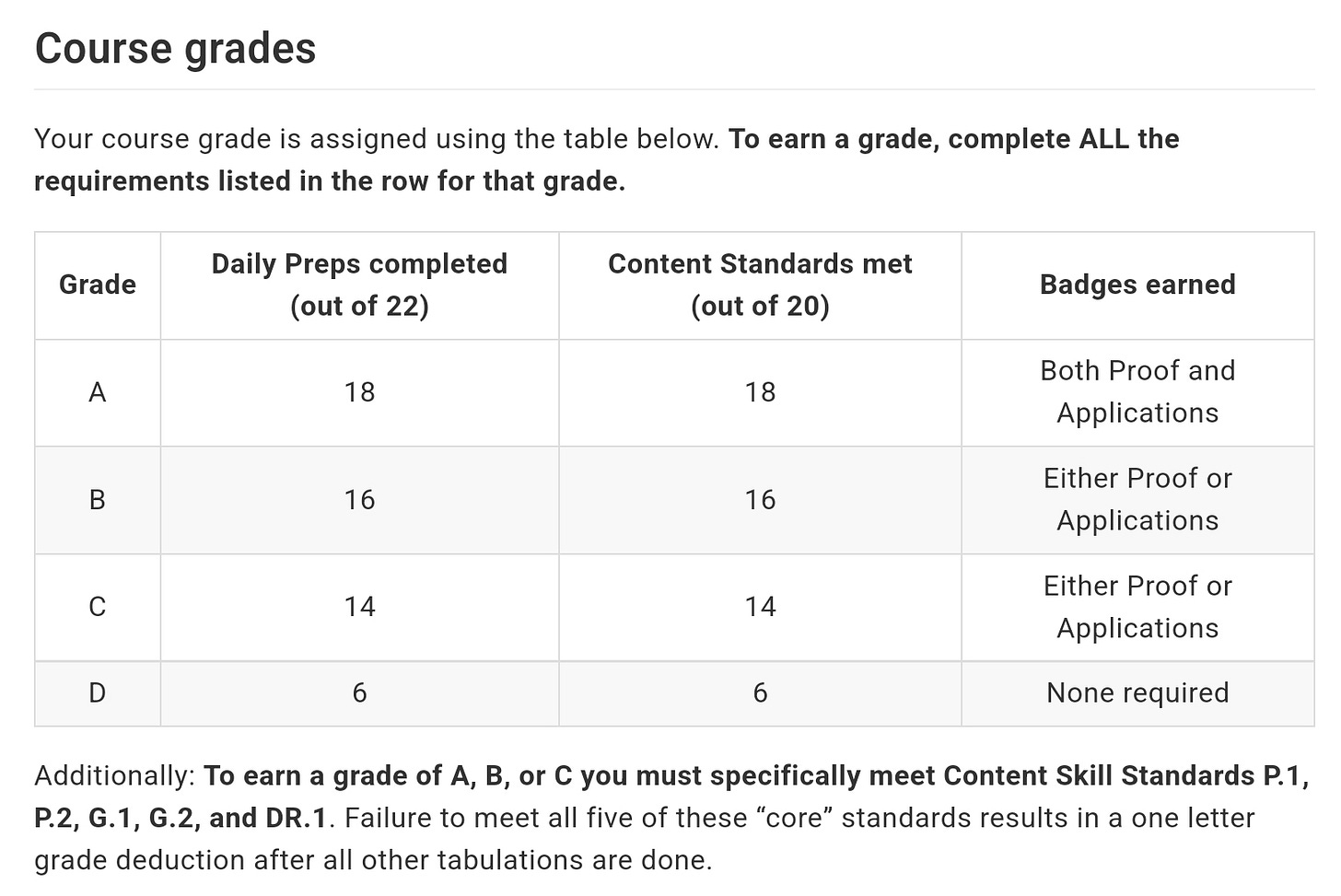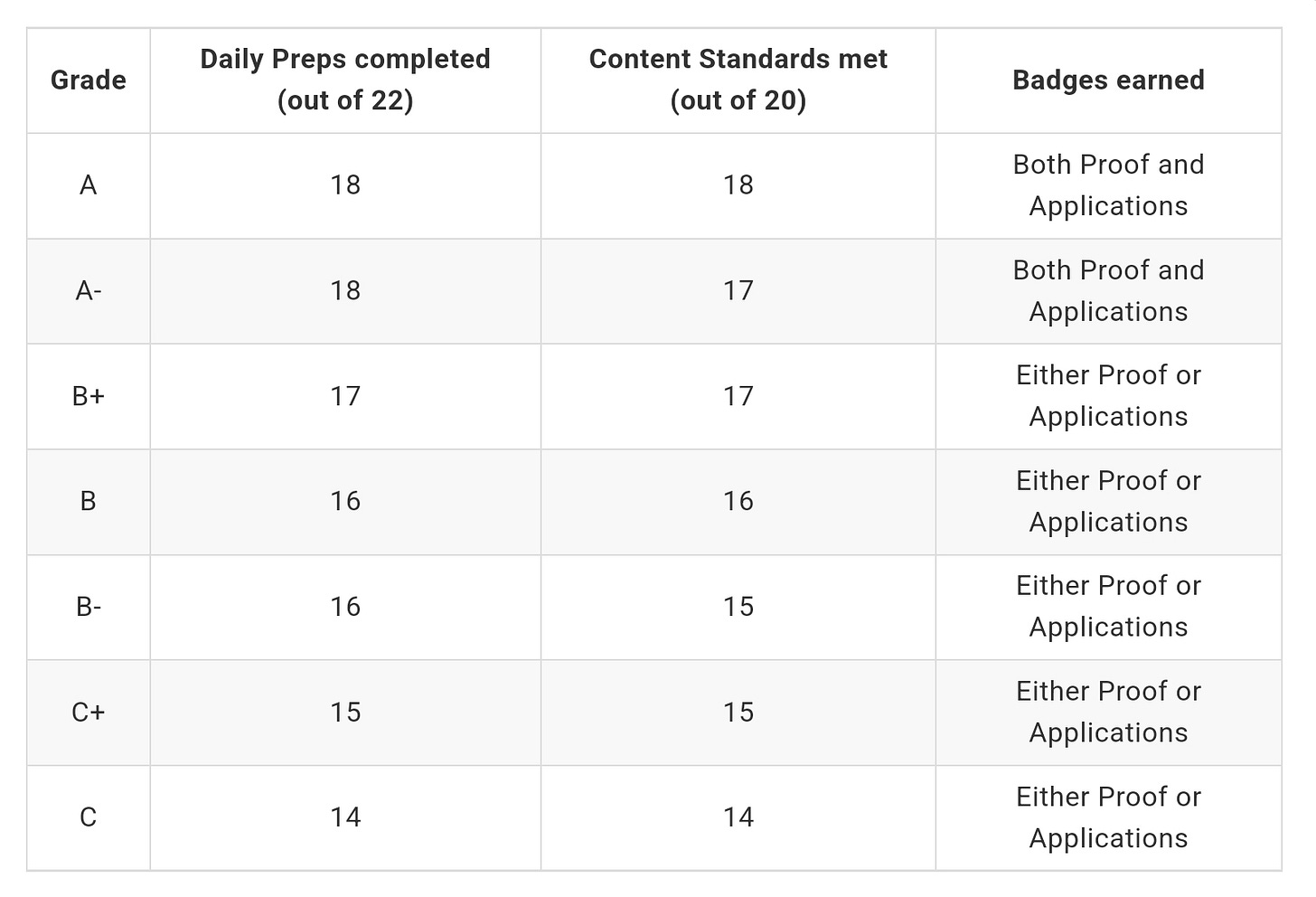Partial grades for growth
Five methods for handling plus/minus grades in an alternative system.
No matter where you stand on how, or whether, individual items of student work should be graded, one thing is almost certainly true: You'll have to assign course grades to each student at the end of the term. Most approaches we’ve written about here are fairly straightforward for assigning "whole" grades -- A, B, C, D, or F. But things get murky when we have to consider partial grades: The "plus" and "minus" versions of these grades.1
How might we best work with partial grades in courses where we are trying to focus on growth with our grading? This week, I want to do a somewhat-deep dive (not nearly as deep as David's geek-out posts on spreadsheets) on some ways to handle partial grades in a way that's consistent with the "grading for growth" philosophy.
Base grades
I'll use the term "base grade" to mean the "whole" grades of A, B, C, D, or F that we assign students for the entire course. The reason for the word "base" will become clear in a minute. In alternative grading setups, we typically determine base grades at the end of the semester in one of two basic ways.
One way is through a grade table in which each row corresponds to a letter grade and each column is a category where students can make progress: number of standards met, a check box for completing a task, and so on. If you teach with standards-based grading, then your grade table is just a mapping of number of standards met onto the base grades. Students receive a base grade if they meet all the requirements in the row for that grade. Here's an example from one of my current courses:
(A base grade of F is assigned if not all the requirements for a D are met.)
The second way is through a narrative or a description of what a base grade "looks like". Students earn a base grade by demonstrating (through a portfolio, or a conversation with the professor, etc.) that they've met the description for that grade. This is the approach that ungrading takes, and it can be used in other systems too.
I like to use the term "base" grade because I think of partial grades as modifiers to the base grades, rather than entirely separate grade categories. It helps me remember that letter grades, if we must have them, should represent broad categories of quality and growth; and the plus/minus grades, if we must have those, don't have a distinct existence but are tied to those broad categories.
You may be required to offer partial grades, but if your university is like mine, there is no rule that states how to assign partial grades. That opens the door for at least five different methods for assigning partial grades that, in our view, stay true to the grading-for-growth mindset.
Method 1: Include partial grades in the table or narratives
In this method, you make out your grade table or base grade narratives with the base grades first. Then insert new rows for all the partial grade combinations, with requirements or narratives that fall in between the whole grade listings in appropriate ways.
Here is a partial example of how this might look, using the grading table for my course from above. This is just a mock-up; I’ve never actually done things this way.
(And so on.)
Having requirements for partial grades coded into the grade table like this has its benefits, mostly in its transparency. It's also very spreadsheet-friendly because each grade, including partials, has explicit conditions under which they are assigned. But it also has downsides, primarily is that it makes the grade table very long, and a plus-sized grading table will likely manifest itself in your students' minds as overcomplicated and get your students thinking more about the grades than the growth.
Method 2: Assign partial grades for "above and beyond" and "near misses"
In this approach, you use your table or narratives to assign base grades, and then assign a "+" when a student meets all the requirements for a base grade but also goes above and beyond, not to the level of the next base grade but still more than is required. And assign a "-" if the student almost meets the requirements of a base grade but not quite all of them.
This is the method I'm currently using. In the syllabus below the grade table, there's this:
This method keeps things relatively simple and intuitive. It makes sense that a B+ should mean "everything for a B plus a little more" and that a B- should mean "you did B level work even though you didn't satisfy every single requirement for a B". In my experience with ungrading, in fact, when students assign themselves plus or minus grades, that's precisely the reasoning they use.
The main difficulty with this method is that you have to be very clear what you mean by "above and beyond" and "almost". Without super-sizing the grade table, be explicit about when you'll assign either one of these.
There is also the potential for conflicting signals. One semester, I had a fairly complicated scheme for when a student would earn a plus or a minus ("If X happens and either Y or Z, but not both W and T, happens then a plus is assigned"), and at the end of the semester, it turned out that my scheme took one common outcome and mapped it both to A- and to B+. It was easily resolved (just give the A-) but the lack of simplicity in my system came back to bite me.
Method 3: Use "mini-ungrading"
This method only applies to non-ungrading situations. Here, you assign base grades using a table. Then, for partial grades, you let students decide. Describe in clear, general terms what a "plus" means and what a "minus" means for any base grade. Then, if a student believes their base grade should be modified, they make a case for themselves and back it up with solid reasoning (including a sample of work) and self-reflection. This could be done at an office meeting, or in a written form.
I used this method in a course recently, mostly as a "try before you buy" for ungrading. I was thinking about using ungrading in my next course and wanted to see if and how it worked. Just as I described above, base grades were assigned using a grade table, and then students could make a case for a modified grade if they chose. I was impressed with the results: Some students didn't bother with it, but others made sound arguments and their plus/minus self-assignments almost entirely aligned with my own thinking.
What's nice about this approach is that, if you've been thinking about ungrading, then this is a way to give it a shot that is on a small scale with very little "risk", in the sense that this is only about modifying base grades that are instructor-assigned. It's a good way to open conversations with others about ungrading (and alt-grading in general). But as I've written elsewhere, ungrading of any form tends to be only as good as students' abilities to self-assess. If you've not done ungrading until the very end of the course, then students haven’t had as much of a chance to develop those abilities yet.
Method 4: Use a final exam
In this method, you assign base grades using a grade table or narrative that does not include a final exam. That is, even if you are giving a final exam, you opt not to use it to determine the base grade. Then, you establish upper and lower thresholds for the final exam: Any score above the upper threshold adds a "plus" to the base grade, anything below the lower one earns a "minus".
I don't give final exams any more, but the last time I did, I used this method. The final exam was set up to be 100 points (ew, points!). Students' base grades were figured using other stuff besides the exam. Then, scoring above an 80% on the final added a "plus" to the base grade; anything below a 50% earned a "minus". Students really liked this. It lowered the stakes for a poor showing on the exam; the worst that could happen was dropping half a letter. This was true even if students chose not even to show up for the exam, which a few students did. And while allowing a good all-around performance on the exam to be rewarded, the reward was relatively minimal.
This method can be helpful for instructors who are required to give a final exam in their courses, assuming they aren't forced into using the exam score as a required percentage of the overall grade. However, if you're not required to give a final exam, I would recommend getting rid of it and replacing it with something more authentic and useful (project, end-of-semester exit interviews, etc.) before using this method.
Method 5: Base partial grades on "engagement"
In our final method, base grades are assigned in the usual ways, using evidence of learning. Then they are modified using "engagement", in some way that is quantified or at least clearly and precisely described. For example, you can set upper and lower thresholds for attendance or discussion board participation, and any student who exceeds the upper threshold gets a "plus", and anyone who doesn't meet the lower threshold gets a "minus".
I hesitate to mention this method. As David wrote a while back, "engagement"-related items like attendance and participation are not really evidence of learning, and they tend not to be equitable because they benefit some groups of students more than others. That term, "engagement", is also nearly impossible to define in any satisfactory way; it's more of a feeling that we get when a student does something that looks, to us, like the sort of "engagement" we expect from "good" students. It's probably best left completely out of grading systems.
Still, I bring it up because some might find it useful, and I've used it myself. I set up a series of opportunities for students to earn "engagement credits" in a course (class attendance, responding to an article on the discussion board, etc.). Students could accumulate those credits in different ways, giving them many paths to earning enough credits. Then, I set upper and lower thresholds and used those for plusses/minuses.
So if you insist that engagement should be a component of students' grades, then this method would be a way to do it that still makes real evidence of learning the primary focus of the course grade and allowing engagement to play a minor but nonzero role.
I once asked my Dean whether I had to include partial grades in my syllabus, even though our university had them grades on the books as being available for assignment, or whether I could just opt to have nothing but base grades in my system. I was told that if the university has them as official possibilities, I need to include them in my syllabi. However, there are many creative ways to use partial grades with a system based on feedback and growth.
In fact, if you’ve got a creative use case for partial grades, leave it in the comments!
Some institutions use “half” grades like AB and BC; the same general principles I give for “plus” and “minus” grades apply to them as well.






Thanks for this. I always struggle with how (and whether, since no one has told me I'm required to) incorporate plus and minus grades.
One question: how do these work for students who have earned an 'A' with the base system? For instance, do they need to take the final exam or they drop to an 'A-'? But, presumably they need only perform better than the minus cut off? They don't need to hit the plus threshold to maintain the 'A'?